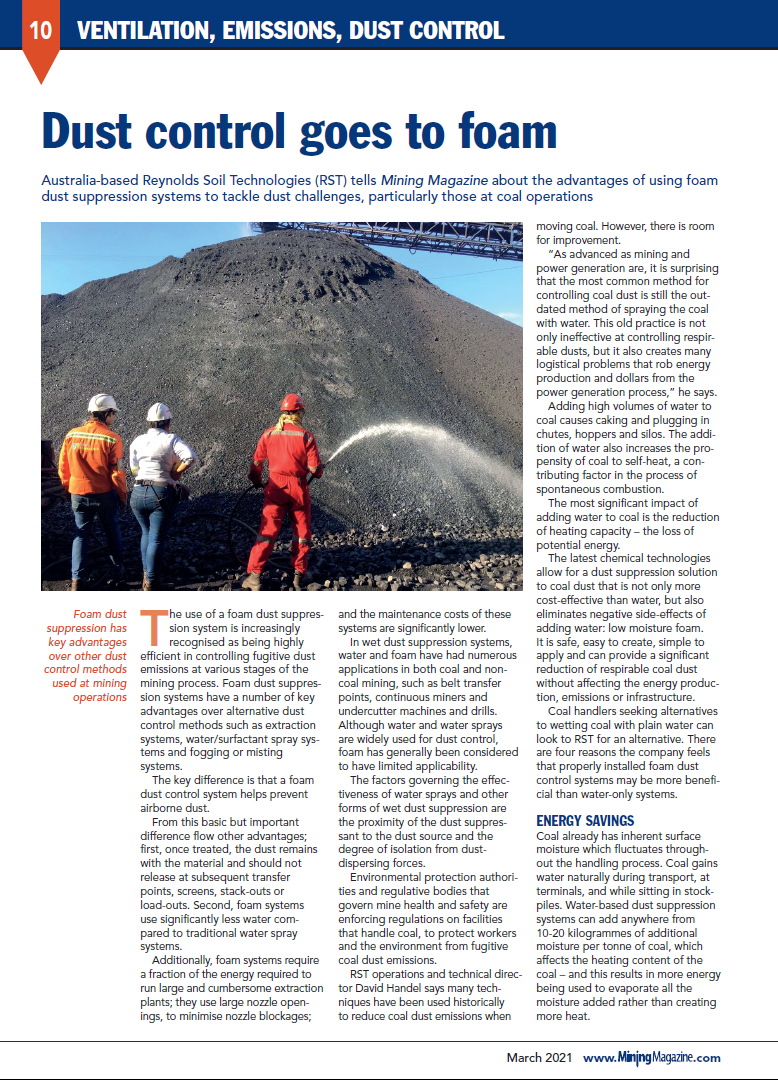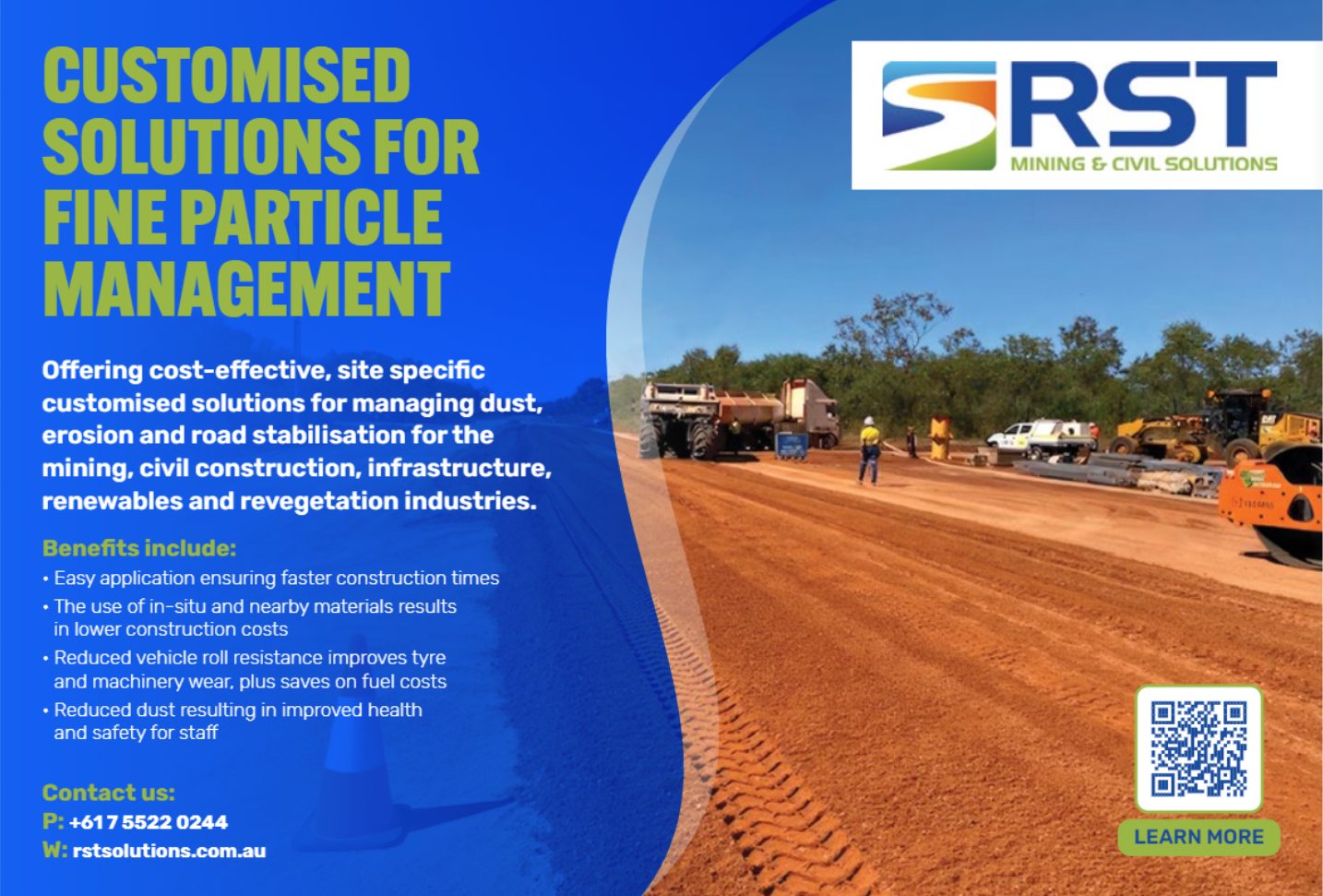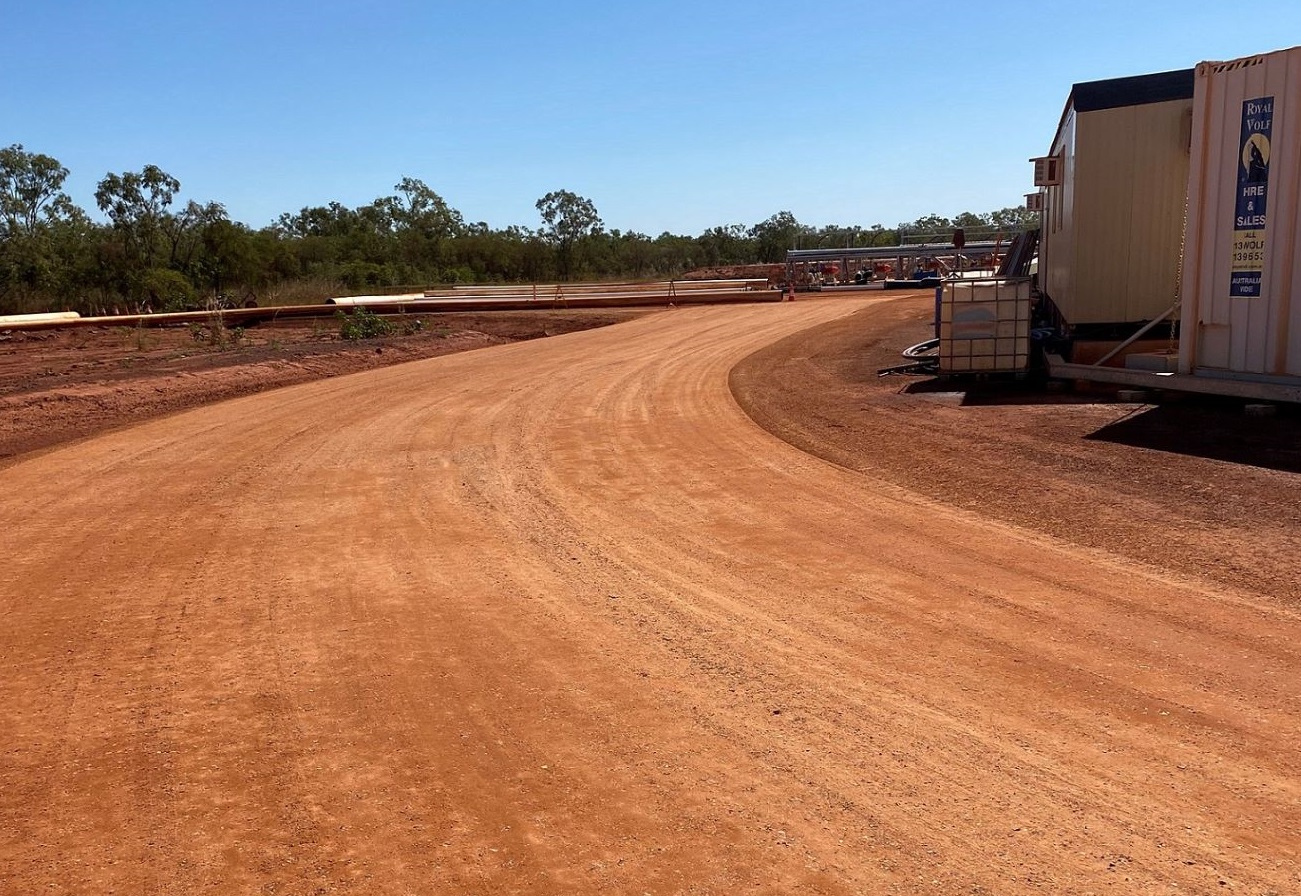
Australia-based Reynolds Soil Technologies (RST) tells Mining Magazine about the advantages of using foam dust suppression systems to tackle dust challenges, particularly those at coal operations
The use of a foam dust suppression system is increasingly recognised as being highly efficient in controlling fugitive dust emissions at various stages of the mining process. Foam dust suppression systems have a number of key advantages over alternative dust control methods such as extraction systems, water/surfactant spray systems and fogging or misting systems.
The key difference is that a foam dust control system helps prevent airborne dust.
From this basic but important difference flow other advantages; first, once treated, the dust remains with the material and should not release at subsequent transfer points, screens, stack-outs or load-outs. Second, foam systems use significantly less water compared to traditional water spray systems.
Additionally, foam systems require a fraction of the energy required to run large and cumbersome extraction plants; they use large nozzle openings, to minimise nozzle blockages; and the maintenance costs of these systems are significantly lower.
In wet dust suppression systems, water and foam have had numerous applications in both coal and noncoal mining, such as belt transfer points, continuous miners and undercutter machines and drills. Although water and water sprays are widely used for dust control, foam has generally been considered to have limited applicability.
The factors governing the effectiveness of water sprays and other forms of wet dust suppression are the proximity of the dust suppressant to the dust source and the degree of isolation from dustdispersing forces.
Environmental protection authorities and regulative bodies that govern mine health and safety are enforcing regulations on facilities that handle coal, to protect workers and the environment from fugitive coal dust emissions.
RST operations and technical director David Handel says many techniques have been used historically to reduce coal dust emissions when moving coal. However, there is room for improvement.
“As advanced as mining and power generation are, it is surprising that the most common method for controlling coal dust is still the outdated method of spraying the coal with water. This old practice is not only ineffective at controlling respirable dusts, but it also creates many logistical problems that rob energy production and dollars from the power generation process,” he says.
Adding high volumes of water to coal causes caking and plugging in chutes, hoppers and silos. The addition of water also increases the propensity of coal to self-heat, a contributing factor in the process of spontaneous combustion.
The most significant impact of adding water to coal is the reduction of heating capacity – the loss of potential energy.
The latest chemical technologies allow for a dust suppression solution to coal dust that is not only more cost-effective than water, but also eliminates negative side-effects of adding water: low moisture foam. It is safe, easy to create, simple to apply and can provide a significant reduction of respirable coal dust without affecting the energy production, emissions or infrastructure.
Coal handlers seeking alternatives to wetting coal with plain water can look to RST for an alternative. There are four reasons the company feels that properly installed foam dust control systems may be more beneficial than water-only systems.
ENERGY SAVINGS
Coal already has inherent surface moisture which fluctuates throughout the handling process. Coal gains water naturally during transport, at terminals, and while sitting in stockpiles. Water-based dust suppression systems can add anywhere from 10-20 kilogrammes of additional moisture per tonne of coal, which affects the heating content of the coal – and this results in more energy being used to evaporate all the moisture added rather than creating more heat.
The ideal solution is to burn coal, maintain the paid energy value and control dust.
Foam dust control typically uses up to 10 times less moisture than water-only systems, and with significantly improved dust control. Foam also prevents the coal from massive gains in moisture, which keeps the energy value up, allowing more coal to burn rather than evaporate water. This is achieved by mixing compressed air with unique foaming agents to deliver a dry-tothe- touch dust-encapsulating blanket of foam.
The blanket of foam instantly adheres to the coal surface, trapping dust fines in a physical barrier while binding them together with a chemical action.
MORE EFFICIENT WORK
Workers, equipment, pumps and the environment all work better in cleaner, healthier air. When the air quality is of a higher standard, operations can be performed more safely, and facilities can operate more efficiently.
Using foam is more effective in reducing harmful environmental effects: air pollution, reduced visibility, accelerated corrosion rates, increased water toxicity, and it also helps avoid regularly clogged filters, pump failures, deficiencies in equipment performance, shortened equipment life and other negative impacts.
Most importantly, the benefits of improved air quality can help minimise the risk of workers’ exposure to coal dust, which is known to be the cause of respiratory and cardiovascular illnesses such as black lung disease and arrhythmias.
AVOIDING UNNECESSARY MAINTENANCE
Eliminating airborne dust with foam instead of water when moving coal improves work safety by helping to minimise equipment failures, corrosion to metal surfaces and infrastructure, reducing the need for daily clean-ups and wash-downs due to dust accumulation and spillage – or, in a worstcase scenario, being required to shut down the power plant to fix a preventable dust-related problem.
PROCESS CHEMISTRY COMPATIBILITY
Advanced foam products complement coal floatation and tailing flocculation systems due to the minimal amounts of actual product used per tonne of coal (5 to 10 millilitres per tonne). It is highly recommended that plant operators run tests to ensure products are compatible with their process chemistry.
ADVANTAGES TO FOAM AND CUSTOM APPLICATION SYSTEMS
The way in which a foaming product is applied to a site can significantly impact performance, which is why it is critical for operations to incorporate specifically designed application systems and equipment to achieve maximum benefits. RST works closely with site operators to design and install custom designed systems and programmes that meet an operation’s specific challenges, and assessing a site’s individual needs for maximum results from each foaming system.
RST’s advanced technology product Hi-Foam is one of its most effective products to control dust with minimal moisture in bulk handling processes. Injected into hopper bins, transfer points and crushers, the foam wets dust particles to increase their weight, so that the dust particles continue through the conveying and crushing system resulting in minimal airborne dust.
When the Hi-Foam solution is applied through a designated application system, it creates a robust foam that captures and engulfs fine particles in a ‘total dust blanket’ effect. The foaming system utilises a dosing feeder that injects the additive directly into the system’s water line, allowing for the manual concentration adjustment of the solution.
The air and water then mix in an expansion chamber capable of supplying a dust suppressing foam to six dosing points introduced at specific stages in the crushing and conveying circuit. When Hi-Foam is injected into crushing plants, it is recommended to inject at each crusher stage, being the primary, secondary and tertiary crushers.
Handel says that the reason is that only enough foam is added at each crusher stage to the exposed coal surfaces and as the coal is crushed at each stage, more untreated coal surfaces are exposed that need to be treated. Adding too much foam at any stage can cause the blinding of crusher screens.
While RST supplies customised application equipment for foaming products, the company has worked closely with process chemists to develop unique dust suppressants that significantly improve dust control efficiency of water spray systems already in use to advance their effectiveness in capturing airborne dust and improving material dust extinction moisture levels without affecting the processing results.
Material type, application equipment and processes, climatic conditions and water availability and quality are among the factors considered by RST when delivering solutions for mining operations, backed by the company’s 30 years in the field of fine particle management.
Over three decades of extensive research and development of products and methods to repair and mitigate a broad range of dust management challenges gives RST the expertise and knowledge to provide operators with cost effective and environmentally friendly solutions, and across a whole range of fine particle issues from plant to port.



